Abstract
Reversible airway obstruction in childhood includes two major groups of patients: those with recurrent wheezing following bronchiolitis in early childhood, and those with allergic asthma, which represents an increasingly large proportion of cases through the school years. Over the last 40 years of the 20th century, allergic asthma has increased in many countries and in relation to several different allergens. Although this increase has differed in magnitude in different countries and also in the social groups most affected, it has had several features in common. The increase generally started between 1960 and 1970, has been progressive since then, and has continued into the 1990s without a defined peak. Among children 5-18 years of age, the increase has predominantly been among allergic individuals. Theories about the causes of the increase in asthma have focused on two scenarios: a) that changes in houses combined with increased time spent indoors have increased exposure to relevant allergens, or b) that changes in diet, antibiotic use, immunizations, and the pattern of infections in childhood have led to a change in immune responsiveness such that a larger section of the population makes T(H)2, rather than T(H)1 responses including IgE antibodies to inhalant allergens. There are, however, problems with each of these theories and, in particular, none of the proposed changes can explain the progressive nature of the increase over 40 years. The fact that the change in asthma has much in common with epidemic increase in diseases such as Type II diabetes or obesity suggests that similar factors could be involved. Several lines of evidence are reviewed that suggest that the decline in physical activity of children, particularly those living in poverty in the United States, could have contributed to the rise in asthma. The hypothesis would be that the progressive loss of a lung-specific protective effect against wheezing has allowed allergic children to develop symptomatic asthma. What is clear is that current theories do not provide either an adequate explanation of the increase or a practical approach to reversing the current trend.
Full text
PDF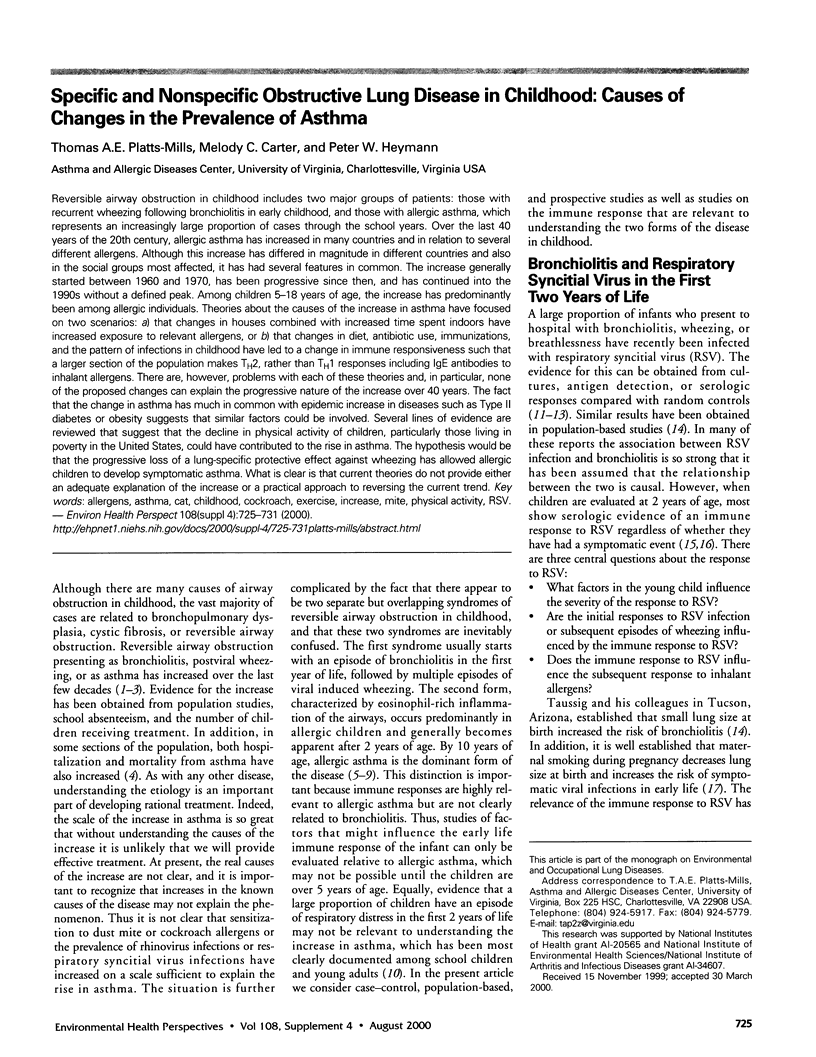
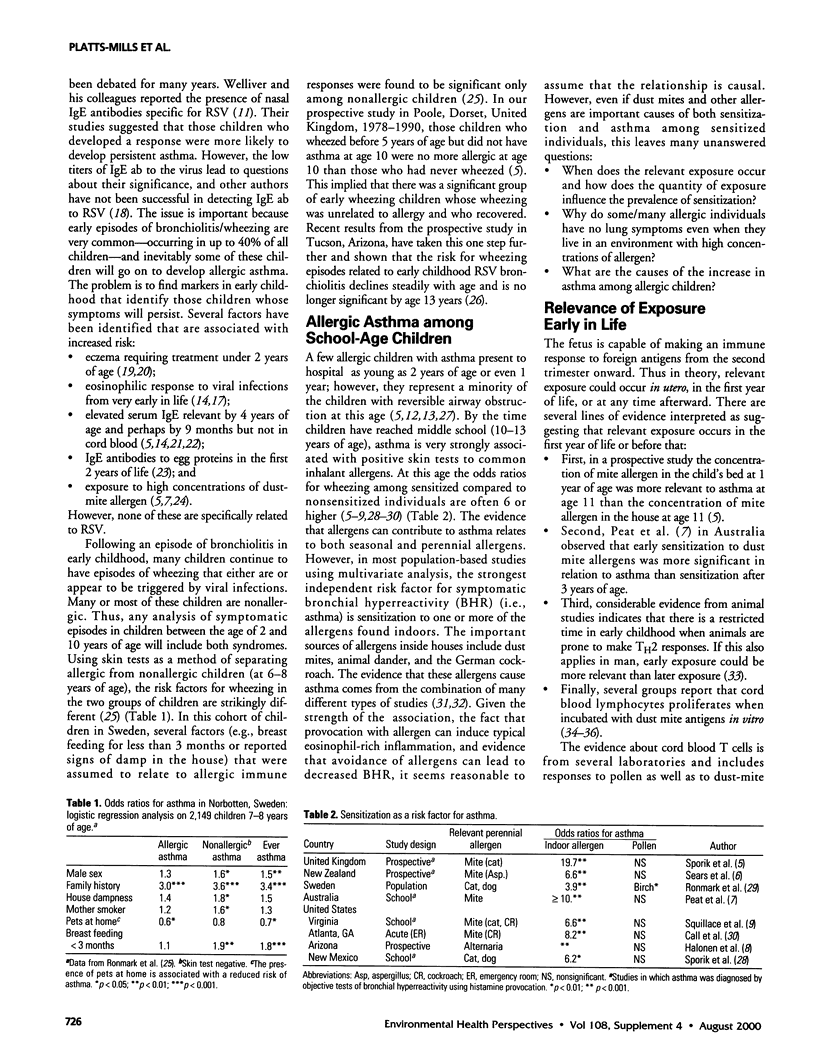
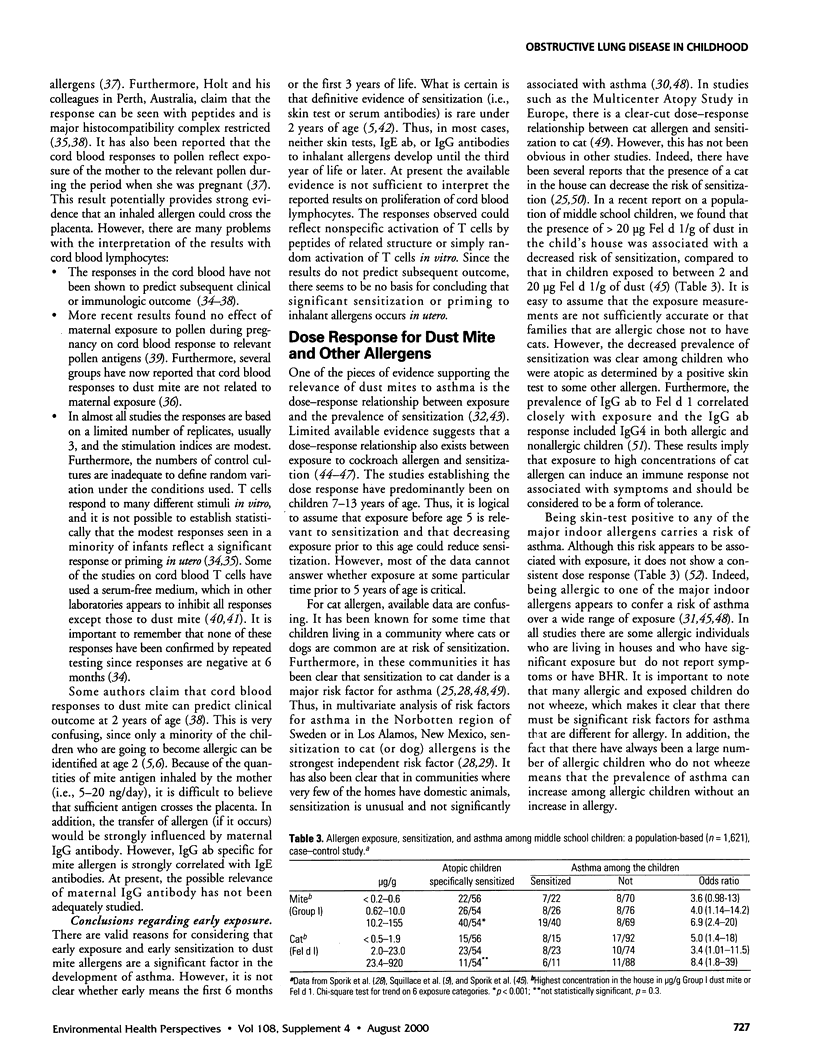

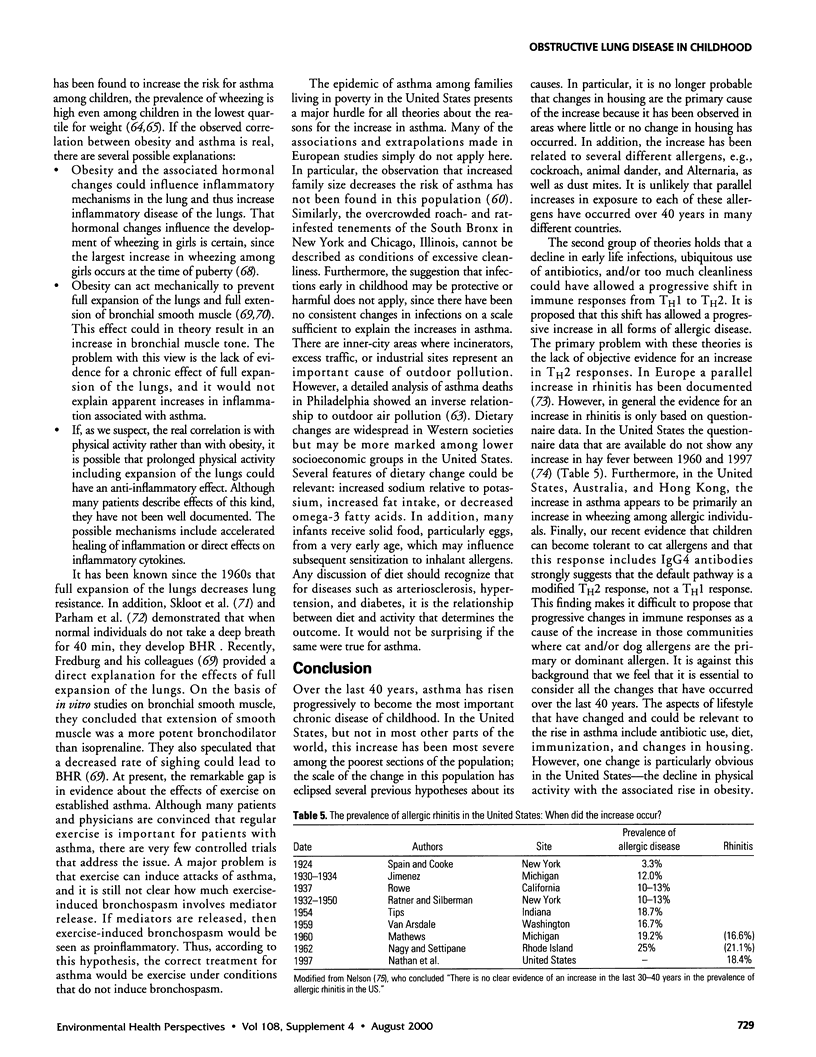
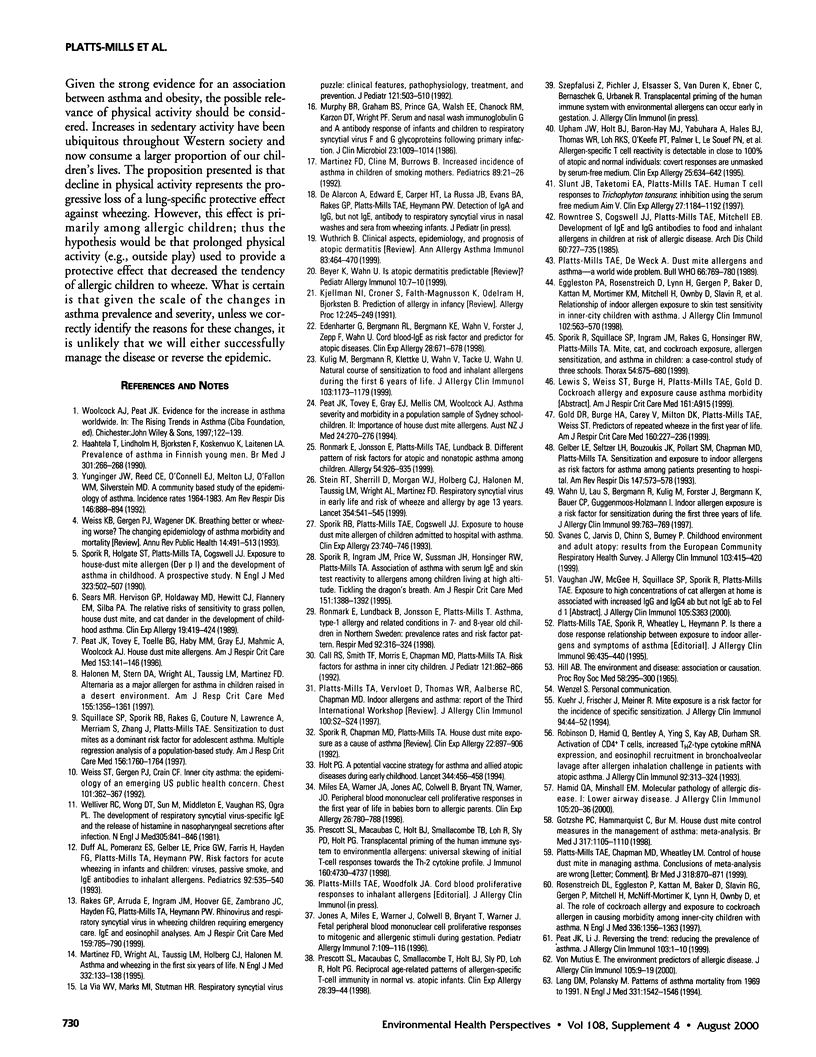
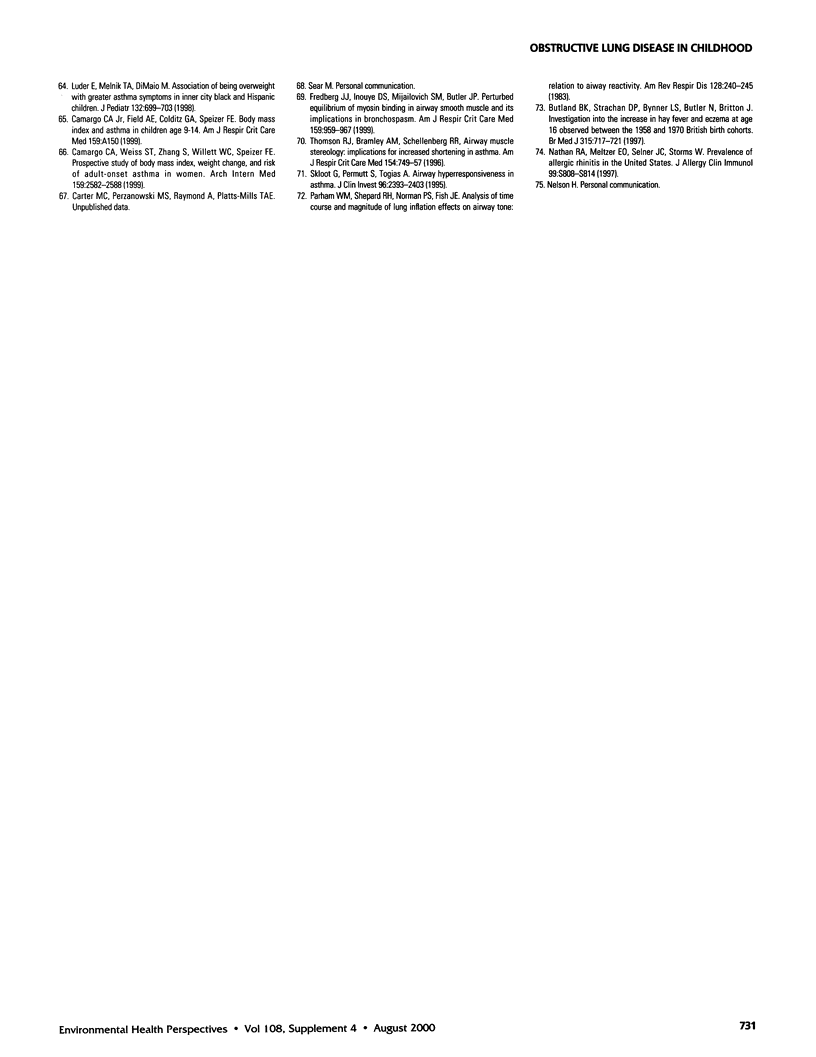
Selected References
These references are in PubMed. This may not be the complete list of references from this article.
- Bacalo A., Kivity S., Heno N., Greif Z., Greif J., Topilsky M. Blood transfusion and lung function in children with thalassemia major. Chest. 1992 Feb;101(2):362–365. doi: 10.1378/chest.101.2.362. [DOI] [PubMed] [Google Scholar]
- Beyer K., Wahn U. Is atopic dermatitis predictable? Pediatr Allergy Immunol. 1999;10(12 Suppl):7–10. doi: 10.1111/j.1399-3038.1999.tb00421.x. [DOI] [PubMed] [Google Scholar]
- Butland B. K., Strachan D. P., Lewis S., Bynner J., Butler N., Britton J. Investigation into the increase in hay fever and eczema at age 16 observed between the 1958 and 1970 British birth cohorts. BMJ. 1997 Sep 20;315(7110):717–721. doi: 10.1136/bmj.315.7110.717. [DOI] [PMC free article] [PubMed] [Google Scholar]
- Call R. S., Smith T. F., Morris E., Chapman M. D., Platts-Mills T. A. Risk factors for asthma in inner city children. J Pediatr. 1992 Dec;121(6):862–866. doi: 10.1016/s0022-3476(05)80329-4. [DOI] [PubMed] [Google Scholar]
- Camargo C. A., Jr, Weiss S. T., Zhang S., Willett W. C., Speizer F. E. Prospective study of body mass index, weight change, and risk of adult-onset asthma in women. Arch Intern Med. 1999 Nov 22;159(21):2582–2588. doi: 10.1001/archinte.159.21.2582. [DOI] [PubMed] [Google Scholar]
- Duff A. L., Pomeranz E. S., Gelber L. E., Price G. W., Farris H., Hayden F. G., Platts-Mills T. A., Heymann P. W. Risk factors for acute wheezing in infants and children: viruses, passive smoke, and IgE antibodies to inhalant allergens. Pediatrics. 1993 Oct;92(4):535–540. [PubMed] [Google Scholar]
- Edenharter G., Bergmann R. L., Bergmann K. E., Wahn V., Forster J., Zepp F., Wahn U. Cord blood-IgE as risk factor and predictor for atopic diseases. Clin Exp Allergy. 1998 Jun;28(6):671–678. doi: 10.1046/j.1365-2222.1998.00241.x. [DOI] [PubMed] [Google Scholar]
- Eggleston P. A., Rosenstreich D., Lynn H., Gergen P., Baker D., Kattan M., Mortimer K. M., Mitchell H., Ownby D., Slavin R. Relationship of indoor allergen exposure to skin test sensitivity in inner-city children with asthma. J Allergy Clin Immunol. 1998 Oct;102(4 Pt 1):563–570. doi: 10.1016/s0091-6749(98)70272-6. [DOI] [PubMed] [Google Scholar]
- Fredberg J. J., Inouye D. S., Mijailovich S. M., Butler J. P. Perturbed equilibrium of myosin binding in airway smooth muscle and its implications in bronchospasm. Am J Respir Crit Care Med. 1999 Mar;159(3):959–967. doi: 10.1164/ajrccm.159.3.9804060. [DOI] [PubMed] [Google Scholar]
- Gelber L. E., Seltzer L. H., Bouzoukis J. K., Pollart S. M., Chapman M. D., Platts-Mills T. A. Sensitization and exposure to indoor allergens as risk factors for asthma among patients presenting to hospital. Am Rev Respir Dis. 1993 Mar;147(3):573–578. doi: 10.1164/ajrccm/147.3.573. [DOI] [PubMed] [Google Scholar]
- Gold D. R., Burge H. A., Carey V., Milton D. K., Platts-Mills T., Weiss S. T. Predictors of repeated wheeze in the first year of life: the relative roles of cockroach, birth weight, acute lower respiratory illness, and maternal smoking. Am J Respir Crit Care Med. 1999 Jul;160(1):227–236. doi: 10.1164/ajrccm.160.1.9807104. [DOI] [PubMed] [Google Scholar]
- Gøtzsche P. C., Hammarquist C., Burr M. House dust mite control measures in the management of asthma: meta-analysis. BMJ. 1998 Oct 24;317(7166):1105–1110. doi: 10.1136/bmj.317.7166.1105. [DOI] [PMC free article] [PubMed] [Google Scholar]
- HILL A. B. THE ENVIRONMENT AND DISEASE: ASSOCIATION OR CAUSATION? Proc R Soc Med. 1965 May;58:295–300. doi: 10.1177/003591576505800503. [DOI] [PMC free article] [PubMed] [Google Scholar]
- Haahtela T., Lindholm H., Björkstén F., Koskenvuo K., Laitinen L. A. Prevalence of asthma in Finnish young men. BMJ. 1990 Aug 4;301(6746):266–268. doi: 10.1136/bmj.301.6746.266. [DOI] [PMC free article] [PubMed] [Google Scholar]
- Halonen M., Stern D. A., Wright A. L., Taussig L. M., Martinez F. D. Alternaria as a major allergen for asthma in children raised in a desert environment. Am J Respir Crit Care Med. 1997 Apr;155(4):1356–1361. doi: 10.1164/ajrccm.155.4.9105079. [DOI] [PubMed] [Google Scholar]
- Hamid Q. A., Minshall E. M. Molecular pathology of allergic disease: I: lower airway disease. J Allergy Clin Immunol. 2000 Jan;105(1 Pt 1):20–36. doi: 10.1016/s0091-6749(00)90172-6. [DOI] [PubMed] [Google Scholar]
- Holt P. G. A potential vaccine strategy for asthma and allied atopic diseases during early childhood. Lancet. 1994 Aug 13;344(8920):456–458. doi: 10.1016/s0140-6736(94)91776-0. [DOI] [PubMed] [Google Scholar]
- Jones A. C., Miles E. A., Warner J. O., Colwell B. M., Bryant T. N., Warner J. A. Fetal peripheral blood mononuclear cell proliferative responses to mitogenic and allergenic stimuli during gestation. Pediatr Allergy Immunol. 1996 Aug;7(3):109–116. doi: 10.1111/j.1399-3038.1996.tb00117.x. [DOI] [PubMed] [Google Scholar]
- Kjellman N. I., Croner S., Fälth-Magnusson K., Odelram H., Björkstén B. Prediction of allergy in infancy. Allergy Proc. 1991 Jul-Aug;12(4):245–249. doi: 10.2500/108854191778879214. [DOI] [PubMed] [Google Scholar]
- Kuehr J., Frischer T., Meinert R., Barth R., Forster J., Schraub S., Urbanek R., Karmaus W. Mite allergen exposure is a risk for the incidence of specific sensitization. J Allergy Clin Immunol. 1994 Jul;94(1):44–52. doi: 10.1016/0091-6749(94)90070-1. [DOI] [PubMed] [Google Scholar]
- Kulig M., Bergmann R., Klettke U., Wahn V., Tacke U., Wahn U. Natural course of sensitization to food and inhalant allergens during the first 6 years of life. J Allergy Clin Immunol. 1999 Jun;103(6):1173–1179. doi: 10.1016/s0091-6749(99)70195-8. [DOI] [PubMed] [Google Scholar]
- La Via W. V., Marks M. I., Stutman H. R. Respiratory syncytial virus puzzle: clinical features, pathophysiology, treatment, and prevention. J Pediatr. 1992 Oct;121(4):503–510. doi: 10.1016/s0022-3476(05)81135-7. [DOI] [PubMed] [Google Scholar]
- Lang D. M., Polansky M. Patterns of asthma mortality in Philadelphia from 1969 to 1991. N Engl J Med. 1994 Dec 8;331(23):1542–1546. doi: 10.1056/NEJM199412083312302. [DOI] [PubMed] [Google Scholar]
- Luder E., Melnik T. A., DiMaio M. Association of being overweight with greater asthma symptoms in inner city black and Hispanic children. J Pediatr. 1998 Apr;132(4):699–703. doi: 10.1016/s0022-3476(98)70363-4. [DOI] [PubMed] [Google Scholar]
- Martinez F. D., Cline M., Burrows B. Increased incidence of asthma in children of smoking mothers. Pediatrics. 1992 Jan;89(1):21–26. [PubMed] [Google Scholar]
- Martinez F. D., Wright A. L., Taussig L. M., Holberg C. J., Halonen M., Morgan W. J. Asthma and wheezing in the first six years of life. The Group Health Medical Associates. N Engl J Med. 1995 Jan 19;332(3):133–138. doi: 10.1056/NEJM199501193320301. [DOI] [PubMed] [Google Scholar]
- Miles E. A., Warner J. A., Jones A. C., Colwell B. M., Bryant T. N., Warner J. O. Peripheral blood mononuclear cell proliferative responses in the first year of life in babies born to allergic parents. Clin Exp Allergy. 1996 Jul;26(7):780–788. [PubMed] [Google Scholar]
- Murphy B. R., Graham B. S., Prince G. A., Walsh E. E., Chanock R. M., Karzon D. T., Wright P. F. Serum and nasal-wash immunoglobulin G and A antibody response of infants and children to respiratory syncytial virus F and G glycoproteins following primary infection. J Clin Microbiol. 1986 Jun;23(6):1009–1014. doi: 10.1128/jcm.23.6.1009-1014.1986. [DOI] [PMC free article] [PubMed] [Google Scholar]
- Parham W. M., Shepard R. H., Norman P. S., Fish J. E. Analysis of time course and magnitude of lung inflation effects on airway tone: relation to airway reactivity. Am Rev Respir Dis. 1983 Aug;128(2):240–245. doi: 10.1164/arrd.1983.128.2.240. [DOI] [PubMed] [Google Scholar]
- Peat J. K., Li J. Reversing the trend: reducing the prevalence of asthma. J Allergy Clin Immunol. 1999 Jan;103(1 Pt 1):1–10. doi: 10.1016/s0091-6749(99)70517-8. [DOI] [PubMed] [Google Scholar]
- Peat J. K., Tovey E., Gray E. J., Mellis C. M., Woolcock A. J. Asthma severity and morbidity in a population sample of Sydney schoolchildren: Part II--Importance of house dust mite allergens. Aust N Z J Med. 1994 Jun;24(3):270–276. doi: 10.1111/j.1445-5994.1994.tb02171.x. [DOI] [PubMed] [Google Scholar]
- Peat J. K., Tovey E., Toelle B. G., Haby M. M., Gray E. J., Mahmic A., Woolcock A. J. House dust mite allergens. A major risk factor for childhood asthma in Australia. Am J Respir Crit Care Med. 1996 Jan;153(1):141–146. doi: 10.1164/ajrccm.153.1.8542107. [DOI] [PubMed] [Google Scholar]
- Platts-Mills T. A., Chapman M. D., Wheatly L. M. Control of house dust mite in managing asthma. Conclusions of meta-analysis are wrong. BMJ. 1999 Mar 27;318(7187):870–871. [PubMed] [Google Scholar]
- Platts-Mills T. A., Sporik R. B., Wheatley L. M., Heymann P. W. Is there a dose-response relationship between exposure to indoor allergens and symptoms of asthma? J Allergy Clin Immunol. 1995 Oct;96(4):435–440. doi: 10.1016/s0091-6749(95)70284-9. [DOI] [PubMed] [Google Scholar]
- Platts-Mills T. A., Vervloet D., Thomas W. R., Aalberse R. C., Chapman M. D. Indoor allergens and asthma: report of the Third International Workshop. J Allergy Clin Immunol. 1997 Dec;100(6 Pt 1):S2–24. doi: 10.1016/s0091-6749(97)70292-6. [DOI] [PubMed] [Google Scholar]
- Prescott S. L., Macaubas C., Holt B. J., Smallacombe T. B., Loh R., Sly P. D., Holt P. G. Transplacental priming of the human immune system to environmental allergens: universal skewing of initial T cell responses toward the Th2 cytokine profile. J Immunol. 1998 May 15;160(10):4730–4737. [PubMed] [Google Scholar]
- Rakes G. P., Arruda E., Ingram J. M., Hoover G. E., Zambrano J. C., Hayden F. G., Platts-Mills T. A., Heymann P. W. Rhinovirus and respiratory syncytial virus in wheezing children requiring emergency care. IgE and eosinophil analyses. Am J Respir Crit Care Med. 1999 Mar;159(3):785–790. doi: 10.1164/ajrccm.159.3.9801052. [DOI] [PubMed] [Google Scholar]
- Robinson D., Hamid Q., Bentley A., Ying S., Kay A. B., Durham S. R. Activation of CD4+ T cells, increased TH2-type cytokine mRNA expression, and eosinophil recruitment in bronchoalveolar lavage after allergen inhalation challenge in patients with atopic asthma. J Allergy Clin Immunol. 1993 Aug;92(2):313–324. doi: 10.1016/0091-6749(93)90175-f. [DOI] [PubMed] [Google Scholar]
- Rosenstreich D. L., Eggleston P., Kattan M., Baker D., Slavin R. G., Gergen P., Mitchell H., McNiff-Mortimer K., Lynn H., Ownby D. The role of cockroach allergy and exposure to cockroach allergen in causing morbidity among inner-city children with asthma. N Engl J Med. 1997 May 8;336(19):1356–1363. doi: 10.1056/NEJM199705083361904. [DOI] [PubMed] [Google Scholar]
- Rowntree S., Cogswell J. J., Platts-Mills T. A., Mitchell E. B. Development of IgE and IgG antibodies to food and inhalant allergens in children at risk of allergic disease. Arch Dis Child. 1985 Aug;60(8):727–735. doi: 10.1136/adc.60.8.727. [DOI] [PMC free article] [PubMed] [Google Scholar]
- Rönmark E., Jönsson E., Platts-Mills T., Lundbäck B. Different pattern of risk factors for atopic and nonatopic asthma among children--report from the Obstructive Lung Disease in Northern Sweden Study. Allergy. 1999 Sep;54(9):926–935. doi: 10.1034/j.1398-9995.1999.00044.x. [DOI] [PubMed] [Google Scholar]
- Rönmark E., Lundbäck B., Jönsson E., Platts-Mills T. Asthma, type-1 allergy and related conditions in 7- and 8-year-old children in northern Sweden: prevalence rates and risk factor pattern. Respir Med. 1998 Feb;92(2):316–324. doi: 10.1016/s0954-6111(98)90115-9. [DOI] [PubMed] [Google Scholar]
- Sears M. R., Herbison G. P., Holdaway M. D., Hewitt C. J., Flannery E. M., Silva P. A. The relative risks of sensitivity to grass pollen, house dust mite and cat dander in the development of childhood asthma. Clin Exp Allergy. 1989 Jul;19(4):419–424. doi: 10.1111/j.1365-2222.1989.tb02408.x. [DOI] [PubMed] [Google Scholar]
- Skloot G., Permutt S., Togias A. Airway hyperresponsiveness in asthma: a problem of limited smooth muscle relaxation with inspiration. J Clin Invest. 1995 Nov;96(5):2393–2403. doi: 10.1172/JCI118296. [DOI] [PMC free article] [PubMed] [Google Scholar]
- Slunt J. B., Taketomi E. A., Platts-Mills T. A. Human T-cell responses to Trichophyton tonsurans: inhibition using the serum free medium Aim V. Clin Exp Allergy. 1997 Oct;27(10):1184–1192. [PubMed] [Google Scholar]
- Sporik R., Chapman M. D., Platts-Mills T. A. House dust mite exposure as a cause of asthma. Clin Exp Allergy. 1992 Oct;22(10):897–906. doi: 10.1111/j.1365-2222.1992.tb02062.x. [DOI] [PubMed] [Google Scholar]
- Sporik R., Holgate S. T., Platts-Mills T. A., Cogswell J. J. Exposure to house-dust mite allergen (Der p I) and the development of asthma in childhood. A prospective study. N Engl J Med. 1990 Aug 23;323(8):502–507. doi: 10.1056/NEJM199008233230802. [DOI] [PubMed] [Google Scholar]
- Sporik R., Ingram J. M., Price W., Sussman J. H., Honsinger R. W., Platts-Mills T. A. Association of asthma with serum IgE and skin test reactivity to allergens among children living at high altitude. Tickling the dragon's breath. Am J Respir Crit Care Med. 1995 May;151(5):1388–1392. doi: 10.1164/ajrccm.151.5.7735590. [DOI] [PubMed] [Google Scholar]
- Sporik R., Platts-Mills T. A., Cogswell J. J. Exposure to house dust mite allergen of children admitted to hospital with asthma. Clin Exp Allergy. 1993 Sep;23(9):740–746. doi: 10.1111/j.1365-2222.1993.tb00361.x. [DOI] [PubMed] [Google Scholar]
- Sporik R., Squillace S. P., Ingram J. M., Rakes G., Honsinger R. W., Platts-Mills T. A. Mite, cat, and cockroach exposure, allergen sensitisation, and asthma in children: a case-control study of three schools. Thorax. 1999 Aug;54(8):675–680. doi: 10.1136/thx.54.8.675. [DOI] [PMC free article] [PubMed] [Google Scholar]
- Squillace S. P., Sporik R. B., Rakes G., Couture N., Lawrence A., Merriam S., Zhang J., Platts-Mills A. E. Sensitization to dust mites as a dominant risk factor for asthma among adolescents living in central Virginia. Multiple regression analysis of a population-based study. Am J Respir Crit Care Med. 1997 Dec;156(6):1760–1764. doi: 10.1164/ajrccm.156.6.9704026. [DOI] [PubMed] [Google Scholar]
- Stein R. T., Sherrill D., Morgan W. J., Holberg C. J., Halonen M., Taussig L. M., Wright A. L., Martinez F. D. Respiratory syncytial virus in early life and risk of wheeze and allergy by age 13 years. Lancet. 1999 Aug 14;354(9178):541–545. doi: 10.1016/S0140-6736(98)10321-5. [DOI] [PubMed] [Google Scholar]
- Svanes C., Jarvis D., Chinn S., Burney P. Childhood environment and adult atopy: results from the European Community Respiratory Health Survey. J Allergy Clin Immunol. 1999 Mar;103(3 Pt 1):415–420. doi: 10.1016/s0091-6749(99)70465-3. [DOI] [PubMed] [Google Scholar]
- Thomson R. J., Bramley A. M., Schellenberg R. R. Airway muscle stereology: implications for increased shortening in asthma. Am J Respir Crit Care Med. 1996 Sep;154(3 Pt 1):749–757. doi: 10.1164/ajrccm.154.3.8810615. [DOI] [PubMed] [Google Scholar]
- Upham J. W., Holt B. J., Baron-Hay M. J., Yabuhara A., Hales B. J., Thomas W. R., Loh R. K., O'Keeffe P. T., Palmer L., Le Souef P. N. Inhalant allergen-specific T-cell reactivity is detectable in close to 100% of atopic and normal individuals: covert responses are unmasked by serum-free medium. Clin Exp Allergy. 1995 Jul;25(7):634–642. doi: 10.1111/j.1365-2222.1995.tb01111.x. [DOI] [PubMed] [Google Scholar]
- Wahn U., Lau S., Bergmann R., Kulig M., Forster J., Bergmann K., Bauer C. P., Guggenmoos-Holzmann I. Indoor allergen exposure is a risk factor for sensitization during the first three years of life. J Allergy Clin Immunol. 1997 Jun;99(6 Pt 1):763–769. doi: 10.1016/s0091-6749(97)80009-7. [DOI] [PubMed] [Google Scholar]
- Weiss K. B., Gergen P. J., Wagener D. K. Breathing better or wheezing worse? The changing epidemiology of asthma morbidity and mortality. Annu Rev Public Health. 1993;14:491–513. doi: 10.1146/annurev.pu.14.050193.002423. [DOI] [PubMed] [Google Scholar]
- Wüthrich B. Clinical aspects, epidemiology, and prognosis of atopic dermatitis. Ann Allergy Asthma Immunol. 1999 Nov;83(5):464–470. doi: 10.1016/S1081-1206(10)62852-9. [DOI] [PubMed] [Google Scholar]
- Yunginger J. W., Reed C. E., O'Connell E. J., Melton L. J., 3rd, O'Fallon W. M., Silverstein M. D. A community-based study of the epidemiology of asthma. Incidence rates, 1964-1983. Am Rev Respir Dis. 1992 Oct;146(4):888–894. doi: 10.1164/ajrccm/146.4.888. [DOI] [PubMed] [Google Scholar]
- von Mutius E. The environmental predictors of allergic disease. J Allergy Clin Immunol. 2000 Jan;105(1 Pt 1):9–19. doi: 10.1016/s0091-6749(00)90171-4. [DOI] [PubMed] [Google Scholar]


